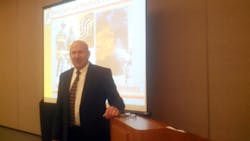Find full coverage of Firehouse World in San Diego this week on Firehouse.com and also on Twitter and Facebook.
SAN DIEGO – Firehouse World kicked off with pre-conference sessions, including the eight-hour course, "ISFSI Principles of Modern Fire Attack," taught by Kevin Milan, fire marshal with South Metro, Colo., Fire Rescue.
The class was a roll out presentation of the International Society of Fire Service Instructors' (ISFSI) program that was funded with grant money from the federal Fire Act Grant program.
“We’ve been doing a lot of things right over the years, but there are those who have been saying we’re doing it all wrong,” said Milan, who has been in the fire service for over 25 years.
Milan began his presentation with a review of the basics of fire behavior and fire science and introduced some advanced and sometimes contrary concepts throughout the day.
Find: #FirehouseWorld2015 on Twitter
“We’re not here to tell you to change what you’ve been doing, but we want to show you the new science that’s out there,” Milan said.
He said historically there has been training that says don’t put water on smoke and that ventilation has to be only vertical – go to the roof. Milan said that may not be the best way to handle ventilation.
The course also delved into the modern fire science of S.L.I.C.E. – R.S. which means Size-up, Location of the Fire, Isolate the Flow Path, Cool from a Safe Distance, Extinguish and then Rescue and Salvage. SLICE-RS is a break from the tradition fire ground tactics that say rescue should always the first effort in fire suppression, Milan said.
He also said the most dangerous phrase in the English language is: “We’ve always done it that way.” He said the Emergency Medical Service profession has embraced change nearly from its inception.
“From my days as an EMT, remember how every time you go for CPR recertification, it’s changed,” Milan said. “We (firefighters) have entrenched ourselves with tradition. We need to look at new ideas with the same open mind as we do with EMS.”
Controlling fire flows and cooling from the outside is not new, Milan said, noting that in the 1890s, it was common. It was only in the 1960s with the invention of modern personal protective equipment (PPE) and SCBAs that aggressive interior firefighting has occurred.
Milan said that back in the 1950s, Fire Chief Lloyd Layman, from Parkersburg, W.Va. wrote about his experience with Naval firefighting using compartmentalization to extinguish fire.
In 1983, Chicago Fire Department had a technique to use quick water to hit project fires with a deck guns while crews were stretching lines for interior attack.
He also added that quick water is the best water when it comes to fireground tactics and the science has proven that any water improves conditions.
“We have got to develop the right blend of practitioner, research and science,” Milan said. “We don’t see enough fires to become experts and we need to understand more about the why of everything.”
Milan said people need to understand and think about the science of how fire behaves and understand that sometimes ventilation is not the best answer and working basement fires might need different thinking than other types of fire.
“Always and never are dangerous words,” Milan said. “Research supports what we’ve done, but it will take training to makes us faster, more efficient and able to reduce risks.
As the morning review of the basics was nearing completion, Milan said there’s one thing he wanted all the attendees to learn.
“We have got to become thinking firefighters,” Milan said.
About the Author

Ed Ballam
Ed Ballam served as associate editor for Firehouse. He is the assistant chief of the Haverhill Corner, N.H. Fire Department, and a National Registered EMT. He is also a Deputy Forest Fire Warden for the New Hampshire Division of Forests and Lands. Professionally, he's been a journalist for over 35 years working for a variety of publications, including employment as managing editor of a national fire service trade journal for more than a decade.
